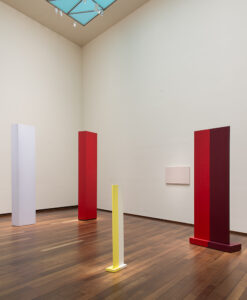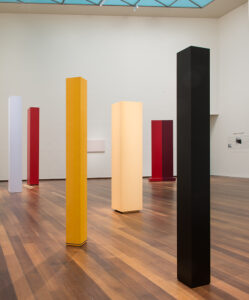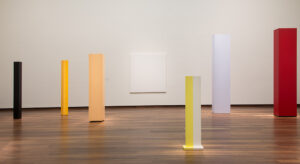 The mid 1960s saw an array of overlapping art styles vying for dominance, from Warhol’s Pop icons to Lewitt’s Conceptual work and Judd’s cool Minimalism. Exhibitions attempting to define these movements were often organized by their canonical male figures and even institutional surveys that aimed at enshrining the avant-garde rarely included women. With few exceptions, women were not recognized as part of this pantheon.
The mid 1960s saw an array of overlapping art styles vying for dominance, from Warhol’s Pop icons to Lewitt’s Conceptual work and Judd’s cool Minimalism. Exhibitions attempting to define these movements were often organized by their canonical male figures and even institutional surveys that aimed at enshrining the avant-garde rarely included women. With few exceptions, women were not recognized as part of this pantheon.
Coming of age as an artist in Washington DC in the ‘60s, Anne Truitt found herself in dialogue with the burgeoning Minimalist movement. Her stark forms resonated with the aesthetic trends gaining traction in New York. The motives behind Truitt’s innovative geometric work, however, were far removed from those of Minimalist figurehead Donald Judd’s cerebral, objective constructs. Truitt was an unwitting Minimalist; her works were contextualized within an existing critical framework, referenced within a trending coterie, but she was never an avowed proponent of the idiom or its postmodern stance. A truly independent spirit, Anne Truitt does not neatly fit into a category.
Truitt navigated the gender disparity of a male-centric art world with varying degrees of success. “The sexism cannot be exaggerated,” she related in a recent interview. Like many women artists of her generation, Truitt continued without major sales or recognition until her much deserved, late-life rediscovery.
A new survey exhibition at Washington DC’s National Gallery of Art, Anne Truitt: In the Tower, highlights over a half dozen of her signature columns, a form she explored for most of her career. In keeping with Truitt’s desire to have her work viewed in 360 degrees, the spartan sculptures are arranged in the gallery with no particular didactic order or chronology, letting the viewer walk freely among them. The exhibit covers a forty-year span of columns, from the 1962 five-foot yellow and white homage to her friend, Mary Pinchot Myers, called Mary’s Light to
Twining Court II a seven foot-tall slim black pillar from 2002. Truitt purposefully scaled her work to human dimensions rather than architectural ones; at various times she alluded to them as figures, untethered and free. They were a friendly entourage that staves off the loneliness that would follow her throughout her life and career.

With the exception of the icy blue horizontal Parva XII (1977), there is in Truitt’s sculptures an aspirational impulse in their verticality. These works reference prehistoric cultures’ axis mundi, the pillars that symbolically connect earth and sky. She spent a large part of her life in Washington DC, where urban architects designed colonnades and massive monuments embedded with neo-classical symbolism; there were columns everywhere. Yet Truitt‘s stelae-like works do not function as markers of ceremonial, astronomical, funerary or boundary locations; rather, they mark her own territory. As acts of resistance these columns reclaim a symbol of power and stability. These ideas are reinforced by titles such as Knight’s Heritage (1963) and Insurrection (1962.) Firmly rimmed with a wraparound base, the early columns seem weighted and immovable. In later works, Truitt removed the base, allowing the pillar to rest flush with the ground, as if rooted in a natural environment.
Wood was Truitt’s material of choice because “it grows slow, like my temperament.” She hired fabricators from local lumberyards to build her poplar or mahogany boxes, but was not focused on the objective character of industrial products like her minimalist contemporaries. She considered her works to be gallery objects and prioritized the hand in her meticulously painted and luminous surfaces. Truitt insisted her works were about ”light as space,” not space vis à vis the body, like her minimalists contemporaries. In this respect she has more spiritual kinship with Rothko than intellectual affinity with Judd.

Thin and precise, her brushstrokes alternate from horizontal to vertical, either with or against the grain. Her shift to acrylics in the late ‘60s significantly reduced the work’s drying time and freed her to experiment with new techniques of sponging, rolling, and hand-drawing lines. She refined her process by successively sanding and layering the surface, applying up to thirty coats of creamy color. She remained intensely focused on being a studio artist, on the work as a contemplation of pure form through its infinite nuance.
Deeply impressed by Ad Reinhardt’s monotonal, non-monochromatic black paintings, Truitt likewise allowed her hues to subtly emerge over time. Steering clear of coloristic bounce, her colors are inflected, like an elegantly modulated voice varying its pitch. Flower (1969) is painted with three pale yellows, equal in value but slightly varying in hue; it initially appears as a monochrome but steadily reveals colors at the threshold of perception. Other seemingly monochromatic sculptures vary lightly on all four faces as in the crimson Mid Day (1972); this is Truitt’s invitation to a slow journey of discovery. By the 1970s, the somber and muted tones of her early years yield to deep carmines, strident yellows and blacks that give each work its specific emotional tenor.
While committed to the focused isolation of the studio, Truitt was circumstantially well connected via her father, a man close to politics, as was her husband, a prominent journalist. While she was not personally interested in the corridors of power, she benefited from significant friendships and support from an entourage that included art luminaries David Smith, Kenneth Noland and Walter Hopps, and DC proved to be the right place at the right time for this artist. In 1962, when Noland decided to move to New York, Truitt took over his DC studio and began a highly productive period that she designated as expressionistic geometric abstraction, reaching well beyond the dominant Washington Color School.
Noland mentioned Truitt’s work to critic Clement Greenberg who in turn mentioned it to André Emmerich. When all three came to DC for Morris Louis’ funeral, (at which Truitt’s father was a pallbearer,) they visited Anne’s studio. Emmerich offered her a show on the spot, which opened 4 months later. Thus in 1963 at age 42 Anne Truitt had her first solo show in New York at the André Emmerich Gallery.

One year later, Truitt’s husband was appointed Tokyo Bureau Chief for Newsweek and she was forced to shutter the DC studio and follow with her three young children. While captivated by the essentialist aesthetic of Japanese culture and its inherent restraint, Truitt was painfully aware that this was a bad career move for her. Still, for the next three years, she experimented with new materials and fabricators but concluded, “The light is wrong.” Dissatisfied with her work, she destroyed a large part of it, keeping a few columns and some works on paper. Among the works that survived this period is Truitt ‘66 [4] (1966), which hangs in the exhibition’s second gallery and prefigures her idea of folding color into space. On a large white sheet, a red stripe rises across the paper, ending in a slight bend, while an overlapping blue stripe appears to be folded within. Other works on paper line the walls including some graphite drawings, several black and violet architectural silhouettes, and a working drawing for Knight’s Heritage.
Shorty after their return to DC, her husband’s descent into mental illness was exacerbated by alcoholism and became unbearable. As a single mother in the late ‘60s, Truitt contemplated a move to New York, which was quickly becoming the epicenter of a vibrant and supportive artistic community with the likes of Helen Frankenthaler and Agnes Martin. Reluctant to claim her place in a male- centric art world, she decided against the move. The bustling New York scene was anathema to an artist who needed a quiet work space and felt at ease in the provincial DC light. Central to her creative output was a fierce determination to carve out studio time with “tranquility and lucidity of mind… to translate aspiration into achievement with quiet fortitude.” Faced with dwindling financial resources and worry for her children, she accepted a teaching position at the University of Maryland. Although she remained semi-reclusive in the ‘70s and ‘80s, she did not retreat from public life. Besides teaching, she served for years on panels, advisory boards, for NEA grants, and most notably as a Board member at Yaddo, the artist residency where she journaled extensively.

Summer Remembered, 1981
acrylic on wood
overall: 208.28 × 20.32 × 20.32 cm (82 × 8 × 8 in.)
National Gallery of Art, Washington, Gift of Carolyn Small Alper
Truitt rarely focused on the intellectual or critical justification for her work, nor did she truly aspire to be an avant-garde artist. Her intent lies beyond, in a space of gender neutrality, integrity and authenticity. What we know of her inner process transpires from interviews or the journals she kept until her death in 2004. Her writings shed light on an artist fascinated with “the intangibility of essence experienced in the process” and of “reaching for a pure power embedded in the object…” Like Agnes Martin, another artist of her generation whose meditative paintings of grids and stripes were influenced by Zen Buddhism, Truitt’s work draws on quietude and tranquillity to access a transformative potential, or what she called limitlessness.
Mokha Laget is an internationally exhibited artist, independent curator and translator. She lives in an off grid studio in the mountains of New Mexico.
All quotes in italics are taken directly from Anne Truitt’s 3 journals: ‘Daybook’, ‘Turn’ and ‘Prospect’.
volume 32 no 5 May / June 2018 pp 23-25

I really appreciated this article on Anne Truitt with all the details on her life that I knew nothing about. Recently there was a whole year exhibition of 5 of her sculptural towers at the Baltimore Museum of Art called Intersections from October 23, 2016 — November 5, 2017. It was extraordinary and gave the precise sense of her perspective on minimalism. She was born in Baltimore, so it was an homage to her, a sign of respect for the work that she did in her lifetime.
https://artbma.org/exhibitions/anne-truitt.